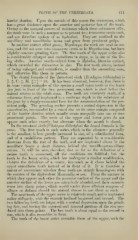Page 401 - My FlipBook
P. 401
TEETH OF THE VERTEBRATA. 411
liarder dentine. Upon the outside of this comes the cementum, which
lias a great thickness upon the anterior and posterior face of the tooth.
Owing to the unequal })owers of resistance which these substances offer,
the teeth wear in such a manner as to present two transverse crests each,
and are therefore spoken of as lophodont. They are confined to the
maxillary and mandibular bones and grow from persistent pulps.
In another extinct allied genus, 3Iegalonyx, the teeth are oval in sec-
tion, and did not wear into transverse crests as in 3Ier/atheriuia, but have
slightly concave grinding faces. The first tooth of the upper series also
is considerably enlarged and caniniform in shape, as in one of the liv-
ing sloths. Another nearly-related form is Mylodon, likewise extinct,
which exceeded the rhinoceros in size. The first tooth above, instead
of being enlarged and caniniform, is smaller than the succeeding ones,
and otherwise like them in pattern.
The dental formula of the three-toed sloth (Bradypus tridndyhts) is
I. ^, C. ^, M. |^z| = 18. It has been observed, however, that there is
in some young examples of this species a small extra tooth in the lower
jaw just in front of the first permanent one, which is shed before the
animal attains to the adult state. The teeth are relatively small, of a
columnar form, and implanted to a moderate depth in the substance of
the jaws by a deeply-excavated base for the accommodation of the per-
sistent pulp. The grinding surface presents a central depression in the
vaso-dentine, surrounded by a raised rim on its outer margin composed
of the harder dentine, which usually wears unequally into one or two
prominent points. The teeth of the upper and lower jaws do not
oppose each other exactly, but alternate when the mouth is closed.
In the two-toed sloth [Choloepus didactylus) the dental formula is the
same. The first tooth in each series, which in the edentates generally
is the smallest, is here greatly increased in size, of a subtrihedral form,
and of a caniniform pattern. They are separated by a considerable
diastema from the rest of the teeth, and are implanted above in the
maxillary bones a short distance behind the maxillo-])remaxillary
suture. It will be seen, therefore, that as far as the definition of a
canine tooth is concerned, all the conditions are fulfilled ; but the
tooth in the lower series, which has undergone a similar modification,
violates the definition of a canine, inasmuch as it closes behind the
upper caniniform tooth instead of in front of it. It is therefore a
matter of uncertainty whether these teeth are strictly homologous with
the canines of the diphyodont Mammalia or not. From the manner in
which they oppose each other the posterior surface of the upper and the
anterior surface of the lower are extensively abraded, and their summits
worn into sharp points, which would render them efficient weapons of
offence or defence should the animal choose to use them as such.
The next tooth of the upper series is relatively small, and is implanted
rather obliquely, with the summit inclined backward and inward. The
two following teeth are larger, with a central depression upon the grind-
ing face, and having the external and internal portions of the rim pro-
duced into sharp points. The last tooth is about equal to the second in
size, which it also resembles in form.
The teeth of the lower series resemble those of the upper, with the


